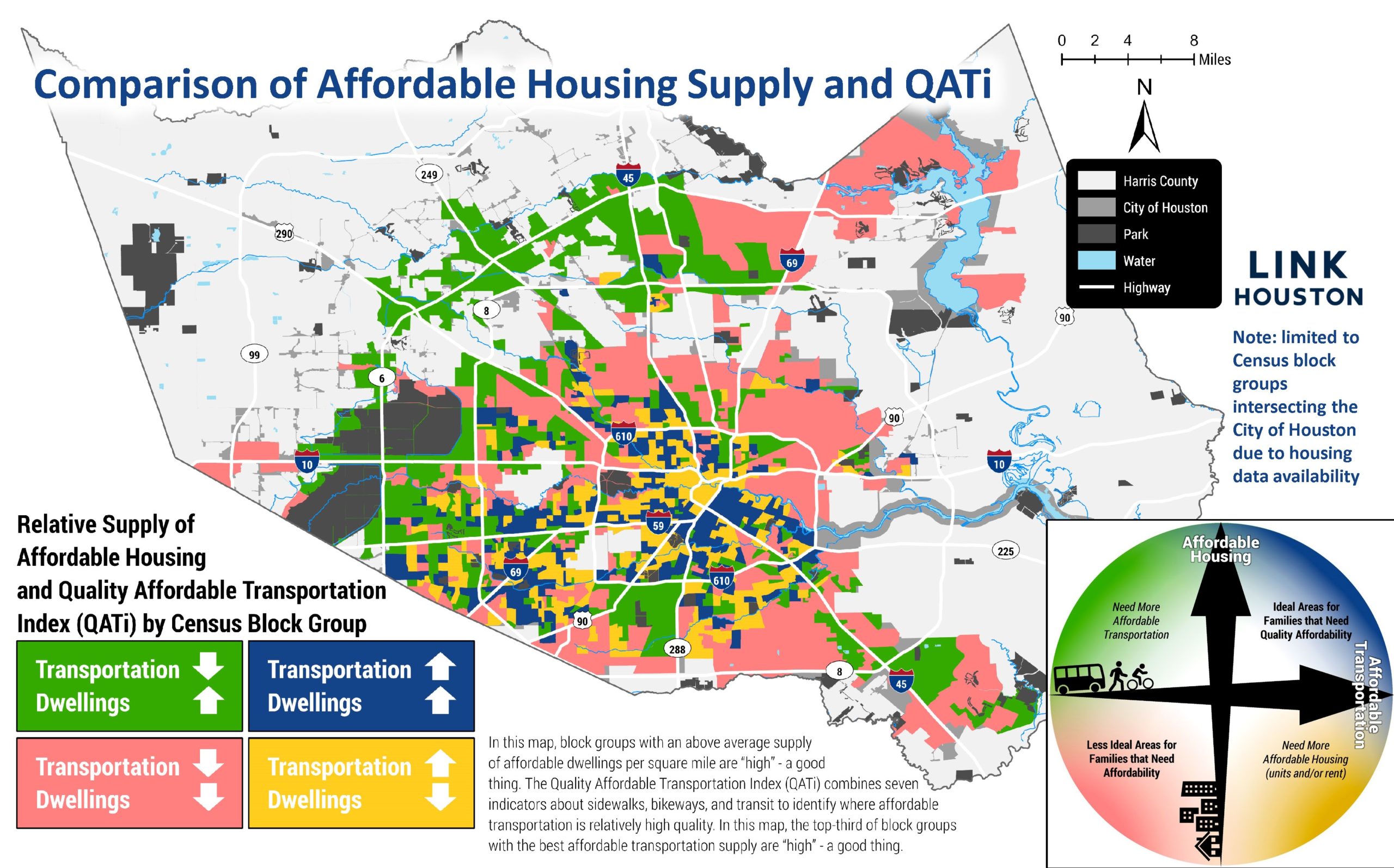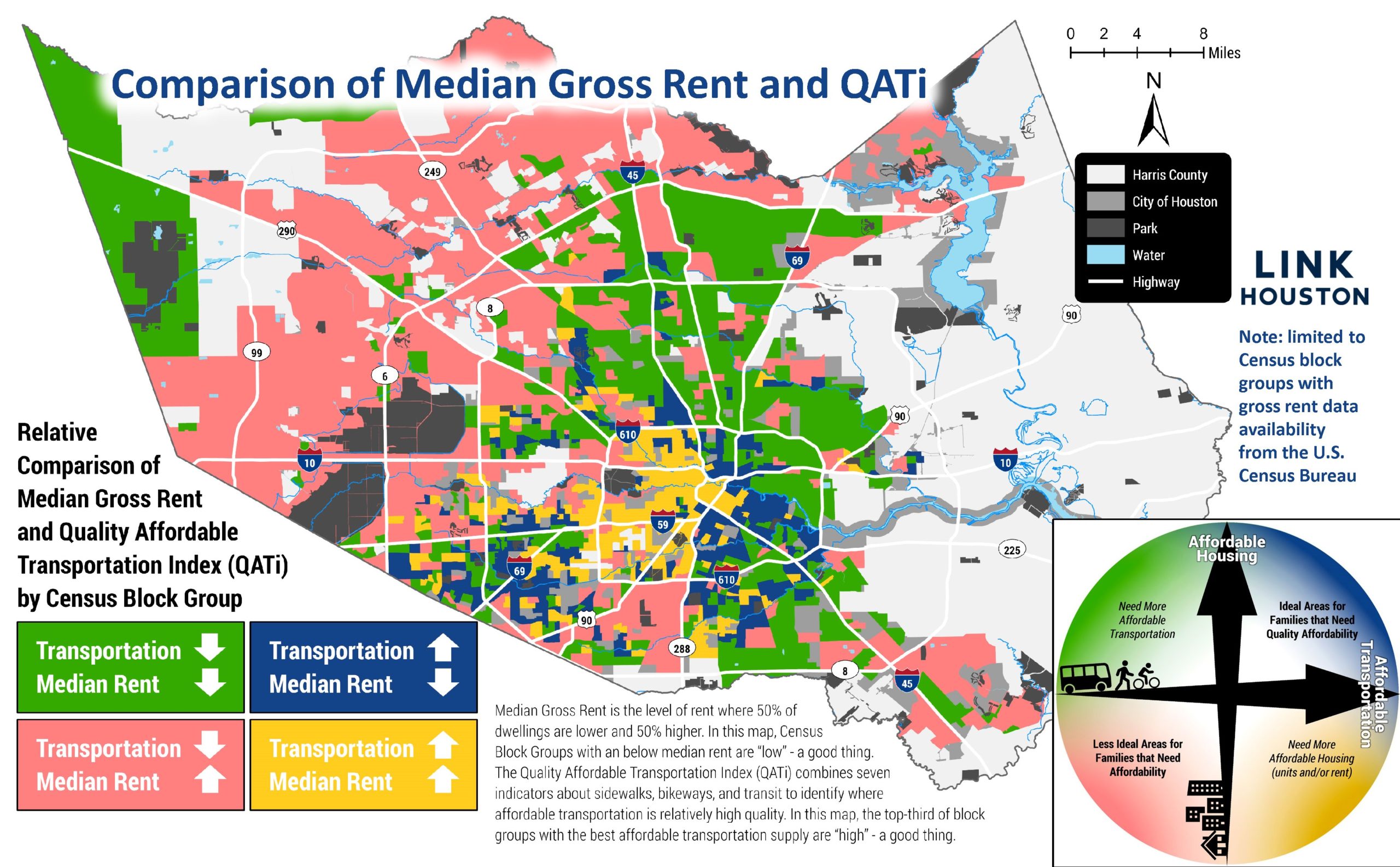Executive Summary
Where Affordable Housing and Transportation Meet in Houston examines where affordable housing and high-quality, affordable transportation presently co-exist. This report provides policy recommendations to help government and nongovernment stakeholders in the City of Houston address affordability issues in the region. This report also aims to help individuals and families make well-informed decisions about where to live to minimize their expenses while accessing social and economic opportunity using quality, affordable transportation — walking on good sidewalks, biking on protected bikeways and riding frequent transit.
Houston faces a decreasing supply of affordable housing to buy and skyrocketing rents. Additionally, people living in the region continue to spend an exorbitant amount on transportation — reflected by increasing rates of vehicle ownership per household — which only compounds the growing affordability challenge. While local decision-makers and individuals tend to view housing and transportation separately, effectively addressing affordability for Houstonians means considering housing and transportation expenses together.
This report relies on the Quality Affordable Transportation Index (QATi), a metric co-developed by LINK Houston and Rice University’s Kinder Institute for Urban Research, to determine where quality, affordable transportation exists today for people walking, biking and riding transit. The report also compares where affordable housing — of any type — occurs and identifies recommendations to improve both housing and transportation quality and affordability.
Additionally, LINK Houston formed the Affordable Housing + Transportation Task Force to collaborate with community members, housing stakeholders and transportation stakeholders to create the Housing + Transportation Decision-maker Scorecard, the Counselor Facilitation Guide and Individual Workbook: Considering Transportation in Your Housing Decision. These assessment tools facilitate connections between future affordable housing investments and affordable, high-quality transportation options and guide individuals and families to consider transportation in their housing decisions.
Based on the research and observations in this report, only 44% of rental units in Houston are affordable to moderate-income households (i.e., a family of four in Houston in 2019 spending no more than $1,907 per month on housing plus utilities) and only 1 out of 3 of those affordable dwellings is near high-quality, affordable transportation. To address affordability issues in Houston, we recommend the following steps to align housing and transportation development:
- Preserve and build affordable housing in areas with high-quality, affordable transportation. Local government and other affordable housing stakeholders must create policies, incentives and resources to prioritize affordable housing developments and improvements in areas where people can access frequent and low-cost transportation. This requires housing stakeholders to coordinate activities and investments with transportation stakeholders.
- Increase opportunities to walk, bike and use transit near affordable housing. Transportation stakeholders — transit officials, regional planning offices, special districts and local government — must prioritize sidewalk, bikeway and transit improvements in areas where affordable housing exists now and will expand in the future.
- Map and monitor affordable housing and affordable transportation to demonstrate and direct the beneficial impacts of policies and investments in affordability for residents. Local governments in the Houston region need to lead in collecting, maintaining and publishing accurate, current data about affordable housing and transportation. Understanding the geographic intersection of housing and transportation helps to target investments, incentives and policies to preserve and develop affordable housing in locations that allow people to walk, bike and use transit, thus maximizing benefits to residents. The research team created the Quality Affordable Transportation & Affordable Housing 2020 Map as a starting point. The map enables affordable housing decision-makers and developers to identify locations where quality, affordable transportation exists today.
- Assess, compare and prioritize potential affordable housing sites to improve access to affordable transportation. Housing stakeholders must consistently and thoroughly consider affordable transportation availability and quality to determine true housing affordability. This report provides the Housing + Transportation Decision-maker Scorecard as a resource for governments or developers to compare sites to better understand how to prioritize affordable housing investments near quality, affordable transportation.
- Develop resources to help people understand how housing and transportation impact overall affordability. Family self-sufficiency and financial counselors must prompt their clients to contemplate location, travel options and transportation expenses in their housing decisions. In addition to directing families to prioritize housing options that score high on the Quality Affordable Transportation Index, this report provides two complementary tools to improve practices at the household level. The Counselor Facilitation Guide provides housing, mobility, self-sufficiency and financial counselors with discussion prompts regarding transportation expenses and housing decisions. The Individual Workbook: Considering Transportation in Your Housing Decision helps people to further understand their transportation needs, consider their goals and identify questions to guide their decision.
Houston stands at an inflection point. While local governments now hold funding for housing recovery and affordable transportation improvements, more and more households struggle to cover their basic needs. Stakeholders must tackle the affordable housing crisis and affordable transportation access together, not independently. Policymakers can lead by uniting planning and implementation of housing and transportation. Public, private and nonprofit stakeholders can prioritize investments to create more “Housed and Connected” areas and to educate individuals and families to consider location and transportation when deciding where to live. Truer affordability through housing and transportation will improve quality of life and economic resilience in all conditions, such as during and after disasters or disruptions such as the COVID-19 pandemic. Individuals and families will spend less time and money accessing opportunity. Employers will have a more stable employee pool. Every Houstonian will be able to live a fuller and productive life.
Full report: Where Affordable Housing and Transportation Meet in Houston


For an online version of the Decision-maker Scorecard, please click here. If you would like an Excel version, please contact LINK Houston at info@linkhouston.org.
Publicly Available Dataset “Affordable Housing and Transportation 2020 Data”
For an interactive StoryMap of “Where Affordable Housing and Transportation Meet in Houston,” please click here.